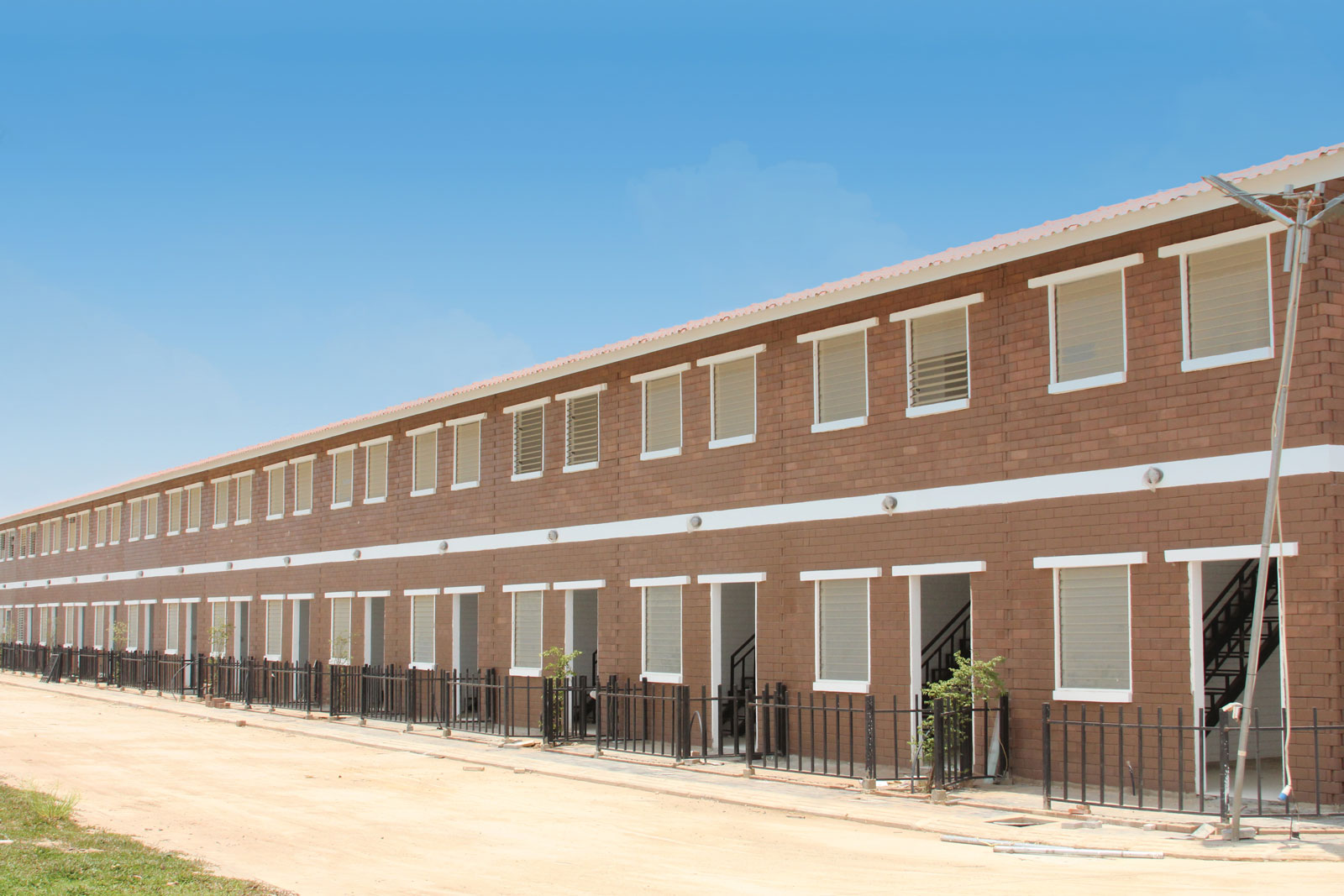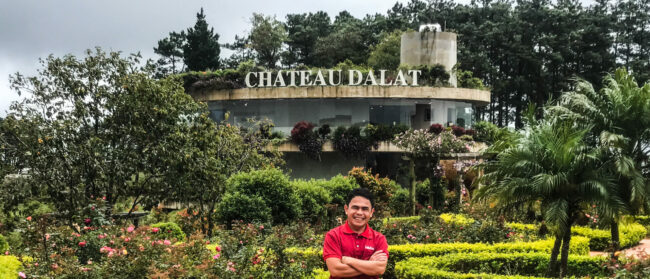The national road to Takhmao is well-paved; lined with dozens of shops, restaurants and markets, it is frequented daily by motorcyclists, tuk tuk drivers, and commercial trucks alike. In between the local shops and stalls, long stretches of undeveloped land line the road, bought by developers – many encouraged by the announcement that a new Cambodian airport would soon be built nearby – with an eye on future large-scale development.
The land in this area now sells for upwards of $100 per square metre. And yet, spread across 20 hectares of it, a community of hundreds of low-income apartments is now taking shape – forming the Kingdom’s first modern-day affordable housing community.
Within the affordable development, roads have been paved and sidewalks have been laid, while plans for the building of additional communal spaces, green parks and a cluster of small- and medium-sized businesses remain in the works. When the complex is complete by the end of 2020, it will be home to more than 2,400 units as well as a clinic, a handful of schools, and a government administrative office.
Built by Worldbridge Homes, a subsidiary of real estate company Oxley WorldBridge Group, the new Takhmao community is preparing to open the doors to its first 800 homes by mid-2019, with more than half of the new units already sold to hundreds of Cambodian civil servants.
“In this whole world, human beings are like a bird,” explained Rithy Sear, chairman of the Oxley Worldbridge Group, as he gestured at the blue sky outside his office window – though no birds could be seen from the height of the 38th floor. “Wherever you fly, you need to come home.”
But as property costs in Cambodia’s capital continue to rise rapidly, locals are struggling to finance their own homes – an issue that Sear says he had foreseen seven years ago, when he initially began research into building public housing. He travelled around the region to inspect the affordable housing communities in Thailand, Singapore, Malaysia and the Philippines to see how he could use key aspects of their models to create a version that best catered to Cambodia’s needs.
“To build a home to stay is not difficult, but it can be hard to maintain, to make sure the people living there can have a job, to ensure there are schools nearby – to build a whole community,” Sear said. “A lot of people don’t understand that there are so many issues you have to consider when you build a low-income housing complex: how do we link the community to the city? Where is the nearest hospital? How do you arrange waste management? You need these things to have a real community.”
The Worldbridge development comes equipped with solutions for many of these challenges. Regarding transportation, Sear has requested government bus service to the community – but failing that, he has plans to personally provide five or six busses to travel daily to and from Phnom Penh at peak hours, linking with the citywide bus system. To ensure currently unemployed locals can find jobs nearby, businesses have been offered the opportunity to open offices in the community’s SME cluster, and local vendors have the right to set up shop along the community’s parkways.
To make the $25,000 homes truly affordable, Worldbridge has also set up agreements with local banks to ensure fairly low interest rates on loans, ensuring that buyers will not have to pay more than $150 monthly – though the payments will span up to 15 years. With the land on which the housing is built rapidly appreciating, there is a policy in place that does not allow these homes to be rented or sold: buyers must buy with the intent to live within the community themselves.
“Our policy is very simple: you are buying to stay… we are creating this as a community, and people living here need to know they are not living alone. They are a part of a cohesive society,” Sear explained. The homes in Sear’s development have been built with community at their core: the fence around the small backyard of each house allows open interaction between neighbours. Tall trees line the roads, and leafy green spaces have been set aside for local community interaction.
We are creating this as a community, and people living here need to know they are not living alone. They are a part of a cohesive society
Rithy Sear
In tandem with the United Nations Development Programme (UNDP), Sear is also working to establish reliable recycling and garbage pickup, water providers and renewable energy sources – each of which would cost a fortune if provided by private companies, thus driving up the cost of living.
According to Nick Beresford, UNDP’s Resident Representative, the programme’s partnership with Sear is especially timely because the need for affordable housing has become crucial for Cambodia’s growing middle class. As the Kingdom becomes more prosperous, the focus must needfully shift to include assurance of housing for all citizens, he explained.
“A key element of a prosperous middle class in Cambodia is the ability to… have a place to live,” said Beresford. “It is of course economic, but it’s also more than that. It’s about community, dignity and a sense of belonging.”
Rising Land Prices
Phnom Penh has become a hub of activity for high-end commercial and residential projects, and the districts in the heart of the city have seen land prices soar up to nearly $4,000 per square metre as a result – increasing the average cost of a 1-bedroom apartment to between $70,000 and $80,000. Prices are steadily climbing on the outskirts of the city as well, according to a 2018 report by Key Real Estate; like Takhmao, land in the suburbs is also going for upwards of $100 per square metre, and prices are increasing in some areas by 7% each year.
While urban land in Cambodia may be cheaper than in other urban centres around Southeast Asia, it’s priced at far above the amount a typical Cambodian can afford: the average local salary in Phnom Penh is only about $270 per month, and while it is on the rise, Cambodia’s average annual household income per capita sat at just below $1,300 at the end of 2016. In contrast, a salary survey of skilled professionals working in the capital – the vast majority of which are foreigners – indicated that expats living in Phnom Penh make an average of $24,000 annually.
“To me, it’s really ridiculous,” Sear said. “What about factory workers? How about farmers and other low-income people? How can they buy a property and a home? Sure they can rent… but then they have nothing to leave their families.”
To accommodate for the city’s lower-paid – and growing – local population, a 2017 study estimated that before 2030, more than 800,000 low-cost urban homes priced at under $30,000 must be built. To reach this target, more than 50,000 affordable homes would have had to have been built each year since the release of this 2017 report – but to date, Sear’s affordable housing development is the only one to come to fruition.
“If you look into the news, there are a few developers who say they want to do an affordable housing project, but I don’t think many will follow through,” Sear said. “There is only one other in the city: a Japanese company building a high rise.”
The Japanese development company that Sear referenced, Arakawa, broke ground in 2017 on its affordable project – a $70 million condominium complex in the capital’s Sen Sok district – the first phase of which is meant to provide 2,000 units priced at between $20,000 to $30,000. Arakawa could not be reached for comment to provide an update on the building’s progress.
The Japanese company has, however, struggled in the past to deliver on its affordable housing promises: after purchasing the 24 hectares of land on which Phnom Penh’s iconic White Building once sat in the heart of the city, the company initially reserved five floors of affordable apartments in the new development for families displaced by the demolition. Less than a year later, though, the company rescinded the offer of housing in lieu of cash settlements, and eventually abandoned all plans to build on the land when it sold the plot to Naga World to be developed as a casino.
Affordable Housing: An Unlikely Trend
According to Charles Villar, general manager of Khmer Real Estate, the affordable housing market is unlikely to take off in the near future.
“In order for developers to make a profit from their affordable housing development, they need to develop land purchased at a price that would be feasible to develop houses for the affordable housing market,” explained Villar. “Big plots of land purchased at $300 to $500 per square metre [in the capital’s city centre] would not make sense for affordable housing development.”
To make building an affordable housing community economically sensible for a private developer, Villar said, developers would need to buy plots of land priced at $20 to $30 per square metre – a price only available about 25 kilometres or more outside of the city. Housing located so far outside of the city pose the same series of problems that Sear’s development is struggling to overcome, in turn limiting their viability for many private developers.
For the Worldbridge affordable housing complex, located 15 kilometres south of the city, Sear purchased the land at just $35 per square metre. But the same land has since appreciated in value, with prices spiking after the government’s announcement that a new, 2600-hectare airport was scheduled to be built nearby.
“It’s a very good thing I’d already bought the land – to be a big developer of affordable housing, you have to buy up land and keep it,” Sear said, adding that he has already purchased hundreds of hectares along national roads 1, 3, 4 and 6a and intends to build more affordable housing complexes on those plots in the future.
“Lucky for me and for the locals… I always plan long.”





